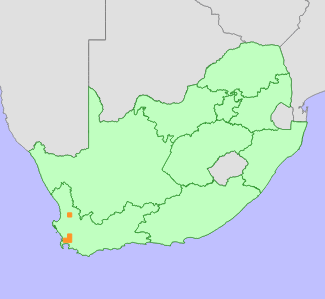|
Scientific Name | Pelargonium leptum L.Bolus |
Higher Classification | Dicotyledons |
Family | GERANIACEAE |
National Status |
Status and Criteria | Vulnerable D2 |
Assessment Date | 2007/10/02 |
Assessor(s) | N.A. Helme & D. Raimondo |
Justification | A naturally rare species known from less than five locations. Subpopulations are small, consisting of only a few scattered adult individuals and are potentially threatened by illegal collecting. |
Distribution |
Endemism | South African endemic |
Provincial distribution | Western Cape |
Range | Olifants River Valley to Cape Flats. |
Habitat and Ecology |
Major system | Terrestrial |
Major habitats | Swartland Shale Renosterveld, Citrusdal Shale Renosterveld, Swartland Granite Renosterveld, Boland Granite Fynbos, Swartland Alluvium Fynbos |
Description | Pockets of shallow, sandy soil on the edges of sheets of exposed rocks. |
Threats |
| This attractive species is not easy to cultivate and therefore potentially threatened by removal of wild plants for the horticultural trade (Craib 2001). |
Population |
Population trend | Stable |
Assessment History |
Taxon assessed |
Status and Criteria |
Citation/Red List version | | Pelargonium leptum L.Bolus | VU D2 | Raimondo et al. (2009) | |
Bibliography |
Craib, C. 2001. Geophytic Pelargoniums. Umdaus Press, Hatfield.
Goldblatt, P. and Manning, J.C. 2000. Cape Plants: A conspectus of the Cape Flora of South Africa. Strelitzia 9. National Botanical Institute, Cape Town.
Marais, E.M. 1994. Taxonomic studies in Pelargonium, section Hoarea (Geraniaceae). Unpublished Ph.D. Thesis, University of Stellenbosch, Stellenbosch.
Raimondo, D., von Staden, L., Foden, W., Victor, J.E., Helme, N.A., Turner, R.C., Kamundi, D.A. and Manyama, P.A. 2009. Red List of South African Plants. Strelitzia 25. South African National Biodiversity Institute, Pretoria.
|
Citation |
| Helme, N.A. & Raimondo, D. 2007. Pelargonium leptum L.Bolus. National Assessment: Red List of South African Plants version 2024.1. Accessed on 2025/11/17 |
 Comment on this assessment
Comment on this assessment


